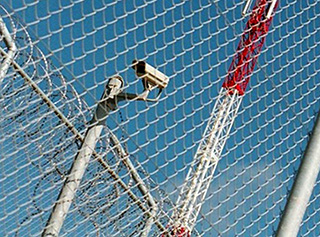STRANDED IN MALTA
2008, video Pal, 11:04, color, stereo ![]() watch video
watch video
The video connects three ways and times of stranding and living in Malta: Saint Paul's believed shipwreck in Malta 2000 years ago (celebrated till today); the Knights Hospitaller's naval battles in the Mediterranean (15th till 18th century); today: immigrants from Africa reach Malta in small boats and live in refugee centres. A journey into Europe's (repressed) memories and collective unconscious ...
2000 years ago: St. Paul was shipwrecked on his way to Rome and stranded on a Mediterranean island. The Maltese are convinced it was Malta, where St. Paul immediately began to evangelize the Maltese population. Up tp now, every year in February they celebrate „St. Paul's Feast“, a large religious holiday, which culminates with the statue of St. Paul being carried out of St. Paul's Shipwreck Church and through the streets of Valetta.
15th to 18th century: Installed in Malta, the Order of the Knights of St. John were Christian Europe’s Mediterranean police, who, on behalf of their member kingdoms and the Pope, defended Christianity and the coasts of the western Mediterranean against the Ottoman Empire (Turks and Arabs) and Islam. This was the time of naval battles and galley-slaves – and whenever a galley sank, all chained rowing slaves drowned.
Today: Immigrants from Africa reach southern Europe (if they survive the journey in the Mediterranean in their small boats). Many of them strand in Malta, and those who are allowed to stay, have to remain in Malta, because the larger countries of „fortress Europe“ don't allow them to immigrate. For years, they live in Malta in provisional refugee centres, sometimes tent villages. Since the times of the Knights Hospitaller, Malta has got many fortresses, but to the refugees it means staying o u t s i d e the wall.
The video STRANDED IN MALTA connects these three ways and times of stranding and living in Malta.
STRANDED IN MALTA
2008, Video Pal, 11:04, Farbe, stereo
Das Video verbindet drei Formen und Zeiten des Strandens und Lebens auf Malta: Den angeblichen Schiffbruch des Heiligen Paulus in Malta (der bis heute gefeiert wird); die Seeschlachten des Johanniter-Ordens im Mittelmeer (sie waren vom 15. bis 18. Jh. in Malta stationiert); heute: Einwanderer aus Afrika erreichen Malta in kleinen Booten und leben in Flüchtlingsunterkünften. Eine Reise in die Erinnerungen und das kollektive Unbewusste / Verdrängte Europas ...
Vor 2000 Jahren: Paulus erlitt auf dem Weg nach Rom, wo er sich dem Gericht stellen musste, Schiffbruch. Er strandete an einer Mittelmeer-Insel – laut Maltesern auf Malta, wo er sogleich begonnen habe, die Bevölkerung für das Christentum zu begeistern. Bis heute feiern die Malteser Paulus jährlich im Februar mit einem großen Festtag und tragen seine Statue unter Jubel aus der St. Paul's Shipwreck Church auf die Straße.
15. bis 18. Jahrhundert: Der Johanniter-Orden bewachte von Malta aus das Mittelmeer, um zumindest einen Teil davon für die christlich-westeuropäischen Mächte und den Papst zu erhalten, und verteidigte dieses Gebiet mit Seeschlachten und Piraterie gegen die muslimischen Türken (Osmanen) und Araber. Dies war die Zeit der Galeerensklaven: Wann immer eine Galeere sank, starben die Rudersklaven – sie ertranken alle, da sie angekettet waren.
Heute: Einwanderer aus Afrika erreichen – wenn sie die Fahrt übers Mittelmeer in ihren kleinen Booten überleben – Südeuropa. Viele stranden in Malta, und wer bleiben darf, muss in Malta bleiben, da die großen Länder der „Festung Europa“ sie nicht einreisen lassen. Sie leben auf Malta jahrelang in provisorischen Unterkünften, manchmal in Zeltstädten. Malta ist seit der Zeit der Johanniter stark befestigt, doch die afrikanischen Flüchtlinge befinden sich symbolisch ausserhalb der Festungsmauern.
CREDITS
All video and sound recordings: Myriam Thyes, Malta and Gozo 2006 + 2007. Where not mentioned differently: all photographs by Myriam Thyes, shot in Malta + Gozo 2006 + 2007, and at the Venice Naval History Museum, 2007. Thyes has used reproductions of drawings and paintings of old ships from the magazine "Sacra Militia" (2002 + 2005) and the book "Navi Venete" (1983). Script, graphics, animation, editing: Myriam Thyes, 2008. Sound mix: Denis Rosen, Dusseldorf
Use of 7 photos, courtesy of: © Chiara Tamburini, Brussels © Dougald Hine, Sheffield
© José Palazun Osma / Asociacion pro derechos de la Infancia Prodein, Melilla, and Umbruch Bildarchiv, Berlin
Thanks
Norbert F. Attard + Marisa, Gozo Contemporary, Gharb, Gozo, Malta
Jesuit Refugee Service Malta, and director Paul Pace
inhabitants of the refugee centre (tent village) in Hal Far, Malta, and centre manager Mick Quinn
inhabitants of the refugee centre Dar Il Kenn in Balzan, Malta, and centre manager Joe Cardona
Pro Asyl, Frankfurt, and Alessandra Sciurba, Venice
Swiss Federal Office of Culture (BAK)
![]() Synopsis as PDF in English / Beschreibung als PDF in Deutsch
Synopsis as PDF in English / Beschreibung als PDF in Deutsch
![]() Stranded in Malta @ Art Cologne 2009
Stranded in Malta @ Art Cologne 2009
![]() video installation MALTA AS METAPHOR
video installation MALTA AS METAPHOR
![]() photo series MAGNIFY MALTA
photo series MAGNIFY MALTA




